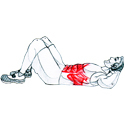-

|
-

|
| Step 1 |
Step 2 |
- Targeted Muscles:
- front abdominal muscles (rectus abdominis)
- Additional Muscles:
- Side abdominal muscles (internal and external obliques)
- To help make abdominal crunches easier, you can cross your arms on top of your chest or keep them a your sides with your palms facing the floor. If your neck feels strained while performing one of these modifications, you can place one hand behind your head for support while keeping the other arm on top of your chest or at your side.
- As your abdominal muscles grow stronger, regular crunches will become easier. For more challenging abdominal crunches, you can stretch your arms out over your head so they are parallel to the floor and then perform the exercise. You can also perform crunches with your legs lifted straight up so your body forms an “L” shape or with your legs lifted and your knees bent at 90-degrees angles. Holding a light weight plate on your chest as you curl up and down can also increase the difficulty of the exercise.
- The abdominal crunch is the most basic and one of the most effective exercises you can perform to strengthen and tone your abdominal muscles. Abdominal muscle strength is a key component of flatter, firmer stomach.
- When performing abdominal crunches, proper form is extremely important in the prevention of injury and in ensuring you get the most out of the exercise. To avoid straining your neck, do not bend your neck or pull your head with your hands as you curl up.
- Keeping your movements slow and controlled, use the upper part of your abdominal muscles to slowly lift your head and shoulders off the floor. You should also keep your lower back pressed to the floor and your elbows pointed out to the sides throughout the exercise.
- If you perform the exercise properly, you should feel a burning sensation in your abdominal muscles by the time you complete about 12 repetitions.
- Do not pull your head forward with your hands. You should not bend your neck
- Do not move your arms back and forth. Keep your elbows out to the sides.
- Do not interlock your fingers behind your head
- Do not lift your feet off the floor.
|











